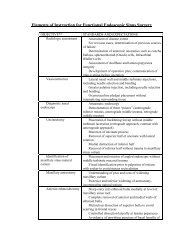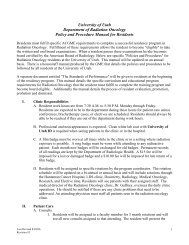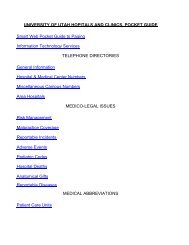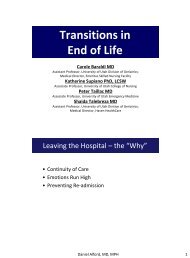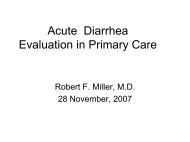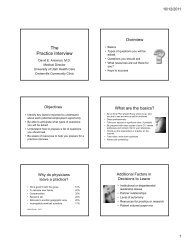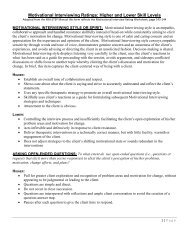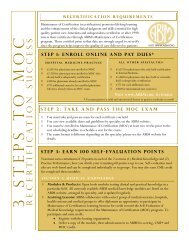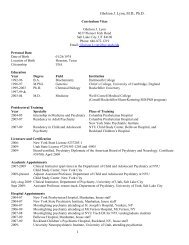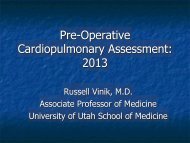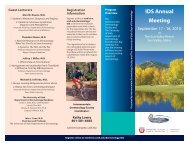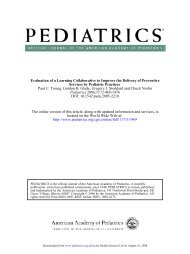Childhood Obesity, Problems and Solutions - University of Utah ...
Childhood Obesity, Problems and Solutions - University of Utah ...
Childhood Obesity, Problems and Solutions - University of Utah ...
Create successful ePaper yourself
Turn your PDF publications into a flip-book with our unique Google optimized e-Paper software.
The <strong>Obesity</strong> Epidemic:<br />
Causes, Consequences <strong>and</strong><br />
Interventions<br />
Paul Young<br />
Department <strong>of</strong> Pediatrics<br />
<strong>University</strong> <strong>of</strong> <strong>Utah</strong> School <strong>of</strong> Medicine<br />
2010 School <strong>of</strong> Medicine Alumni Association Symposium: September 25, 2010
Objectives<br />
• Describe the epidemic<br />
• Overview <strong>of</strong> causes<br />
• What clinicians can do<br />
• Prevention<br />
• Treatment
The <strong>Obesity</strong> “Epidemic”<br />
• In 1985 about 10% <strong>of</strong> Americans were<br />
obese<br />
• Currently about 30% or 60,000,000<br />
Americans are obese
<strong>Obesity</strong> Trends Among U.S. Adults<br />
BRFSS, 1985<br />
(*BMI ≥30, or ~ 30 lbs. overweight (175 lbs) for 5’ 4” person)<br />
No Data
<strong>Obesity</strong> Trends* Among U.S. Adults<br />
BRFSS, 1990<br />
(*BMI ≥30, or ~ 30 lbs. overweight for 5’ 4” person)<br />
No Data
<strong>Obesity</strong> Trends* Among U.S. Adults<br />
BRFSS, 2000<br />
(*BMI ≥30, or ~ 30 lbs. overweight for 5’ 4” person)<br />
No Data
<strong>Obesity</strong> Trends Among U.S. Adults<br />
BRFSS, 2007<br />
(*BMI ≥30, or ~ 30 lbs. overweight for 5’ 4” person)<br />
No Data
• BMI >30<br />
<strong>Obesity</strong> in Adults<br />
– for a 64 inch individual = a weight <strong>of</strong> about 175;<br />
– for a 69 inch person, = a weight <strong>of</strong> 203<br />
• BMI=Wt(KG)/Height 2 (m)<br />
Wt (lbs)X703 /Ht 2 (inches)<br />
• Obese weight=(Ht2X30)/703 • A BMI <strong>of</strong> >25 but < 30 = Overweight<br />
• http://www.cdc.gov/healthyweight/index.html
Being Overweight<br />
has become the “Norm”<br />
Between 1980 <strong>and</strong> 2005 the proportion <strong>of</strong><br />
American adults with a BMI>25 increased<br />
from 47% to 66%<br />
Almost all <strong>of</strong> this increase resulted from an<br />
increase in the number who are obese rather<br />
than overweight.
Defining obesity in children
Why do we need to measure <strong>and</strong> plot BMI?<br />
X<br />
X
<strong>Childhood</strong> <strong>Obesity</strong> trends
1963<br />
2010
Complications <strong>and</strong> Co-<br />
– Dyslipidemia<br />
– High BP<br />
– Abnormal clotting<br />
– Chronic Inflammation <strong>of</strong><br />
vessels<br />
– Stroke<br />
– Type 2 DM<br />
– Polycystic ovary<br />
syndrome<br />
– (NASH) fatty liver<br />
disease<br />
morbidities<br />
– Pseudotumor cerebri<br />
– Sleep Apnea<br />
– SCFE<br />
– Osteoarthritis<br />
– Pregnancy problems<br />
– Depression<br />
– Stigmatization <strong>and</strong><br />
prejudice<br />
– Surgical Complications<br />
– Premature Death
Consequences <strong>of</strong> the<br />
Epidemic<br />
• Increased mortality <strong>and</strong> morbidity<br />
– Cardiovascular consequences related to<br />
the Metabolic Syndrome<br />
– The morbidity <strong>of</strong> nearly every chronic<br />
disease is increased by the presence <strong>of</strong><br />
obesity/overweight<br />
• Shortened life span<br />
• Increased numbers with physical<br />
disabilities
What’s Causing the Epidemic<br />
• Is it “bad” or unhealthy behavior?<br />
• Is it a genetic predisposition?<br />
• Is it the social, physical <strong>and</strong> cultural<br />
environment?<br />
– The “obesogenic” environment
Causes <strong>of</strong> the epidemic<br />
The “Obesogenic” Environment<br />
IN<br />
• Increasing availability <strong>of</strong><br />
inexpensive high calorie foods<br />
– Fast foods<br />
– Supersize portions<br />
– High fat <strong>and</strong> sugar<br />
• Heavy marketing <strong>and</strong><br />
advertising<br />
– $6 billion per year<br />
– McDonalds $1.7 billion<br />
• Agricultural policy<br />
• Changes in family life<br />
OUT<br />
• Decrease in physical activity<br />
– Life <strong>and</strong> work that requires less<br />
energy expenditure<br />
– Less opportunities for<br />
spontaneous play<br />
– Less physical activity in school<br />
• Increased television viewing<br />
<strong>and</strong> screen time<br />
• A built environment that<br />
discourages walking or biking<br />
as modes <strong>of</strong> transport
Why aren’t we all obese?<br />
• <strong>Obesity</strong> results from an excess <strong>of</strong> fat storage<br />
• Fat storage depends upon<br />
– the genetic capacity to store excess energy intake as fat<br />
– the availability <strong>of</strong> energy sources in excess <strong>of</strong> the amount<br />
required (the obesogenic environment)<br />
• The Thrifty Gene Hypothesis<br />
– Neel JV (1962). "Diabetes mellitus: a "thrifty" genotype<br />
rendered detrimental by "progress"?". Am. J. Hum. Genet.<br />
14: 353–62
Possible genetic mechanisms to explain<br />
why we aren’t all obese<br />
• Thrifty genotype or “epigenotype”<br />
• Variations in response to environmental<br />
stimuli<br />
• Variations in how activity affects us<br />
• Variations in the energy costs <strong>of</strong> activity<br />
• Variations in the type <strong>of</strong> fat that we store<br />
– Brown fat vs White fat<br />
• And many more<br />
• Will “personalized medicine” be the answer?
Rationale for Trying to Prevent<br />
<strong>Obesity</strong><br />
• The number <strong>of</strong> children, adolescents, <strong>and</strong><br />
adults who are overweight or obese has<br />
increased dramatically in the past 30 years<br />
• The severity <strong>of</strong> obesity has also increased<br />
substantially<br />
• The prevalence <strong>of</strong> obesity related conditions<br />
<strong>and</strong> illnesses has increased markedly<br />
• Treatment <strong>of</strong> obesity has not been very<br />
successful
Prevention<br />
• Primary<br />
– Message or intervention goes to everyone<br />
• Secondary<br />
– Identify a high risk group<br />
– Give them a specific message or<br />
intervention<br />
• Tertiary<br />
– Prevent complications from the condition
Prevention Strategies<br />
Expert committee from 15 national organizations<br />
(Pediatrics 2007;120 supplement)<br />
Convincing or moderate evidence<br />
1. Limit consumption <strong>of</strong> sugar sweetened beverages<br />
2. 5 servings <strong>of</strong> fruits <strong>and</strong> vegetables daily<br />
3. Limit Screen time to
Prevention Strategies<br />
Expert committee from 15 national organizations<br />
(Pediatrics 2007;120 supplement)<br />
Suggested on basis <strong>of</strong> limited data<br />
1. A diet rich in calcium<br />
2. A diet high in fiber<br />
3. A diet with balanced amounts <strong>of</strong> fat, cho, protein<br />
4. Exclusive breast feeding for 6 months with<br />
maintenance after starting solids for 12 months<br />
5. Moderate to vigorous physical activity for at least<br />
60 minutes daily<br />
6. Limit consumption <strong>of</strong> energy dense foods
Prevention Strategies<br />
The “5-2-1-0” message<br />
5 servings <strong>of</strong> fruits <strong>and</strong> vegetables each<br />
day<br />
A “serving” is about fist size<br />
Less than 2 hours <strong>of</strong> screen time<br />
TV, video games, computer<br />
More than 1 hour <strong>of</strong> exercise<br />
“moderate to vigorous”<br />
Zero sweetened beverages<br />
“no” soda or juice
Prevention for infants<br />
• Start with the mother during pregnancy<br />
– Social Learning Theory<br />
– You are doing this for your baby<br />
• Get mothers to practice the 5-2-1-0<br />
approach for themselves <strong>and</strong> continue it<br />
for the first two years<br />
– A pilot project at the TMCP
Prevention for infants <strong>and</strong> toddlers<br />
“Anticipatory guidance”<br />
1. Breast feed for at least 6 months<br />
– if you are bottle feeding, pretend you’re breast feeding<br />
2. Don’t start solids until 6 months <strong>and</strong> start with<br />
fruits/vegetables not cereal <strong>and</strong> continue breast<br />
feeding<br />
3. Don’t give your infant any sweetened beverages<br />
(yes, this means no juice)<br />
4. Continue to model your 5/2/1/0 activities<br />
• Turn <strong>of</strong>f the TV (2 hours max)<br />
• No soda<br />
• “Wear your baby” so she can be active with you
Wearing your baby
Prevention for children<br />
• Continue the 5-2-1-0 message<br />
– TV <strong>and</strong> videos as baby sitters are learned<br />
behaviors<br />
– Beverages should be low fat milk <strong>and</strong> water (no or<br />
almost no juice)<br />
– Make activity a part <strong>of</strong> every day<br />
• Eat meals together<br />
• Limit fast food meals<br />
• A portion is about the size <strong>of</strong> the child’s fist<br />
• Never force or reward a child for eating
Activity/exercise for prevention<br />
• Exercise during childhood has a favorable<br />
impact on body composition.<br />
– promotes the development <strong>of</strong> lean body tissue<br />
rather than adipose tissue<br />
• Mechanical stimulation signals the<br />
differentiation <strong>of</strong> stem cells into bone <strong>and</strong><br />
muscle <strong>and</strong> away from adipose tissue<br />
Gutin B .Diet vs exercise for the prevention <strong>of</strong> pediatric obesity. International Journal <strong>of</strong> <strong>Obesity</strong><br />
(2010) 1–4
Secondary Prevention<br />
• Family History<br />
Who’s at risk?<br />
– Overweight /obese, type 2 DM, CVD<br />
• IDM<br />
• Rapid early weight gain (more than doubling <strong>of</strong> birth<br />
weight in first 4 months)<br />
– IUGR/ SGA<br />
• Early Adiposity Rebound<br />
• BMI between 85th <strong>and</strong> 95th (at risk for obesity)
Between 2 <strong>and</strong> 6, children should become<br />
skinnier<br />
X<br />
x
Secondary Prevention<br />
“Prevention Plus”<br />
1. “We don’t know why exactly, but we do know<br />
that you will need to work harder than other<br />
parents to prevent your child from becoming<br />
overweight.”<br />
2. “Your child’s BMI is between the 85th <strong>and</strong> 95th<br />
percentile, we need to follow this more closely.<br />
You need to think about portion size <strong>and</strong><br />
sweetened beverages but most important is<br />
figuring out ways for him to be more active <strong>and</strong><br />
to set limits on his screen time.”
Tertiary Prevention<br />
(Treatment)<br />
• 2010 Change in USPTF<br />
recommendation to an “A” (from an I)<br />
regarding treatment effectiveness<br />
• Screen all children for obesity using BMI<br />
• Screen all >95% for co-morbidities<br />
– Lipids, Type 2 DM, NASH
Treatment goals<br />
• Maintain “stable weight” rather than<br />
attempting to lose weight<br />
• Improve fitness<br />
• Chronic Care Model<br />
– Registries <strong>and</strong> case management<br />
– Self-management (regular weighing ?)<br />
– Motivational Interviewing
Effect <strong>of</strong> Maintaining a stable weight<br />
X<br />
X x
The effect on BMI <strong>of</strong> maintaining a<br />
stable weight<br />
X<br />
x
Summary<br />
• We are in the midst <strong>of</strong> an epidemic <strong>of</strong><br />
childhood <strong>and</strong> adult obesity<br />
• The consequences for the health <strong>of</strong><br />
individuals, the US population, <strong>and</strong> the<br />
healthcare system are pr<strong>of</strong>ound<br />
• Prevention starting as early as possible with a<br />
strong emphasis on physical activity is our<br />
best hope for reversing the epidemic <strong>and</strong> its<br />
consequences



